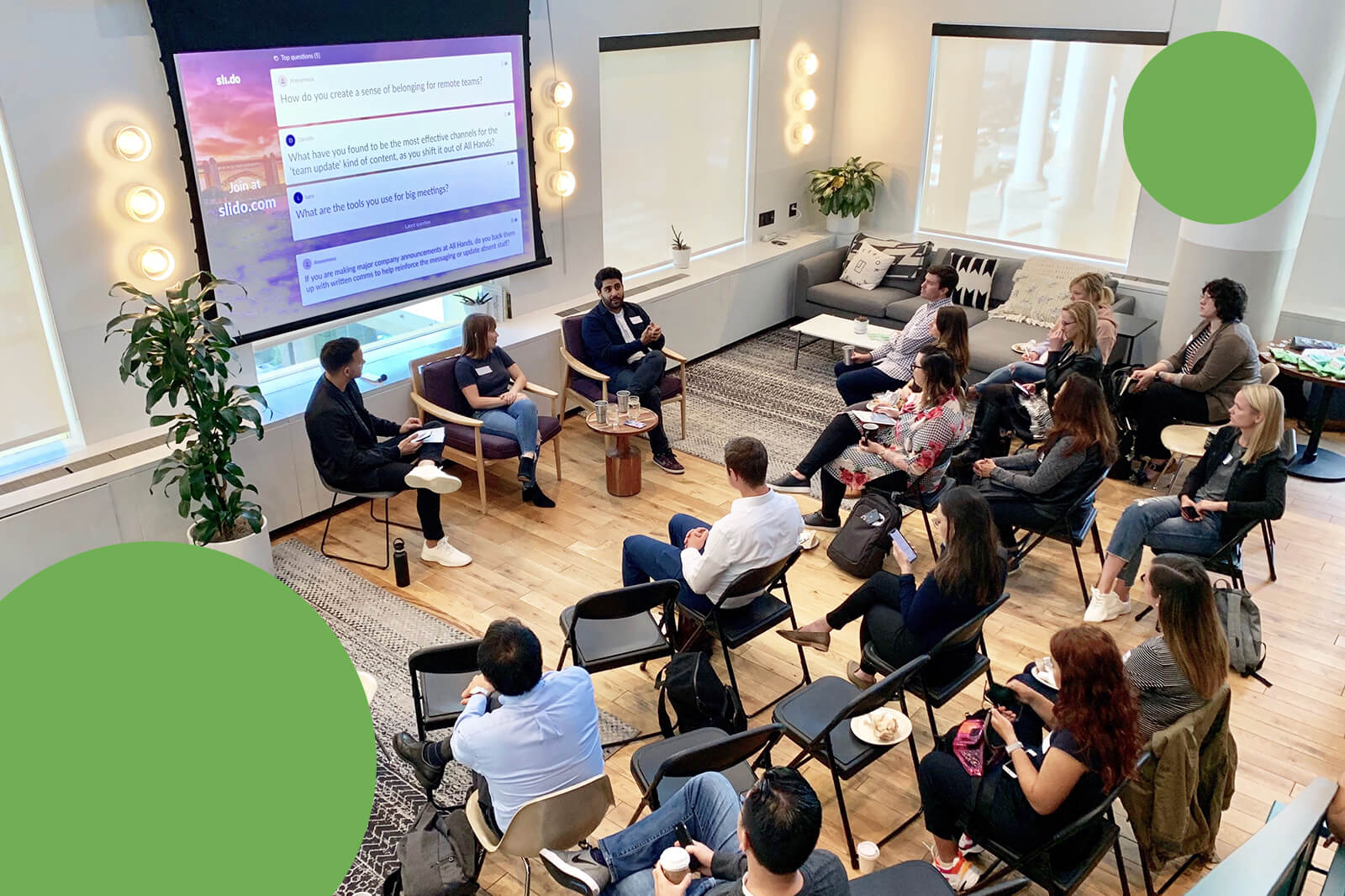The future of work will be built on more effective team collaboration and transparency in communications. This was a central theme of many discussions at last week’s Slack’s customer conference, Frontiers.
To follow up on these debates, we invited Jessica Bauer, Slack’s Internal Communications Manager, and Ashkon Nosrat, Mixpanel’s Senior Employee Engagement Manager, for an insightful fireside chat.
Here’s a quick write-up, summarizing 5 key takeaways from this inspiring discussion.
1. All-hands meetings are more than an avenue for sharing updates
The focus of the fireside chat was on all-hands meetings. Both speakers agreed that they are an integral part of internal communications. If executed well, of course. Having them solely as a means of communicating information to employees one-way is a waste of their potential.
As Ashkon pointed out: “You don’t need an all-hands meeting for sharing updates; there are less expensive ways to do that. The purpose of all-hands is to create a two-way conversation between employees and the exec team. And it’s the role of internal comms to ensure that this conversation is as relevant and valuable as possible.”
2. Good questions deserve good answers
But how do you make sure that the conversations are meaningful? Both Jessica and Ashkon saw it clearly: if you want to build a culture of openness and trust, employees need to have a voice and their voice must be heard.
Ashkon elaborated on this thought: “You won’t satisfy your employees with fluffy answers. You need to go deeper into issues. That’s what allows for a two-way conversation.”
To compensate for the lack of space during the all-hands Q&A, Slack has created a separate avenue for answering employee questions. “Besides our monthly all-hands, which is about sharing the business and company updates, we’ve introduced a monthly town hall. Our town halls don’t have a fixed agenda and they’re fully Q&A based,” explained Jessica.
3. Accommodating remote teams should be internal comms’ main priority
The conversation zoomed in on collaboration with remote teams as well. Both speakers confirmed that involving remote colleagues in the conversation and making them part of the community is absolutely pivotal.
As Jessica said: “An all-hands meeting is a great opportunity to bring the whole company together, to make everyone feel involved. We encourage our remote colleagues to talk to us. We switch times of our all-hands and town halls so that people in different regions have a chance to join us live at some point or another.”
Creating a sense of belonging is a priority at Mixpanel as well. Ashkon told us: “Greeting everyone online is the first thing our CEO does at the all-hands. To our office in Singapore – which is our only office that watches the recorded all-hands the next day – he always sends a separate shout-out, something like, ‘Hi Singapore, who will be watching this tomorrow morning.'”
Acknowledging remote colleagues during meetings is that little thing that makes a big difference.
4. Effective internal comms starts at the top
The speakers also alluded to the common perception of executives growing distant from the rest of the team. Especially as the company grows in size, employees often start to feel that they lose touch with senior leadership.
Jessica explained some of Slack’s tactics to bridge this gap: “One way to give employees access to the execs is the all-hands. Also, our leaders often visit other Slack offices and meet people there. Sometimes, they have lunch with them, other times they run a Q&A session or participate in a fireside chat. They always try to make the most of their presence and make people feel closer to them.”
For employees, being able to approach the execs and knowing that they will be listened to, is key for building transparency in internal communications.
5. Technology is the catalyst for communication
We wouldn’t be able to talk about the future of comms without discussing the role of technology. Besides other tools, both Jessica and Ashkon unanimously voted Zoom as a key player in engaging remote teams.
Ashkon told us how recorded all-hands meetings via Zoom help their remote colleagues feel more involved: “People in our Singapore office watch the recording together. There’s a different element to watching it as a group, as a community. It’s a social moment. People can share thoughts with others and talk about it, which makes the all-hands more valuable for them.”
⏰ Read our latest blog to learn more about asynchronous communication or pre-recorded internal communications.
Slack is another game-changer in internal comms. Jessica told us that they collect employee questions through various Slack channels: “We have a separate channel for our all-hands and town halls and an AMA channel that’s always on. People can ask any questions there. Our comms team collects them and makes sure the responses are being given.”
At Mixpanel, they collect questions through Slack as well. As Ashkon pointed out: “Our execs love to see the questions coming in, so we’ve devoted a Slack channel just for questions to execs.”
Thanks, everyone, for coming to our meetup, especially Jessica and Ashkon for their participation and valuable insights.




